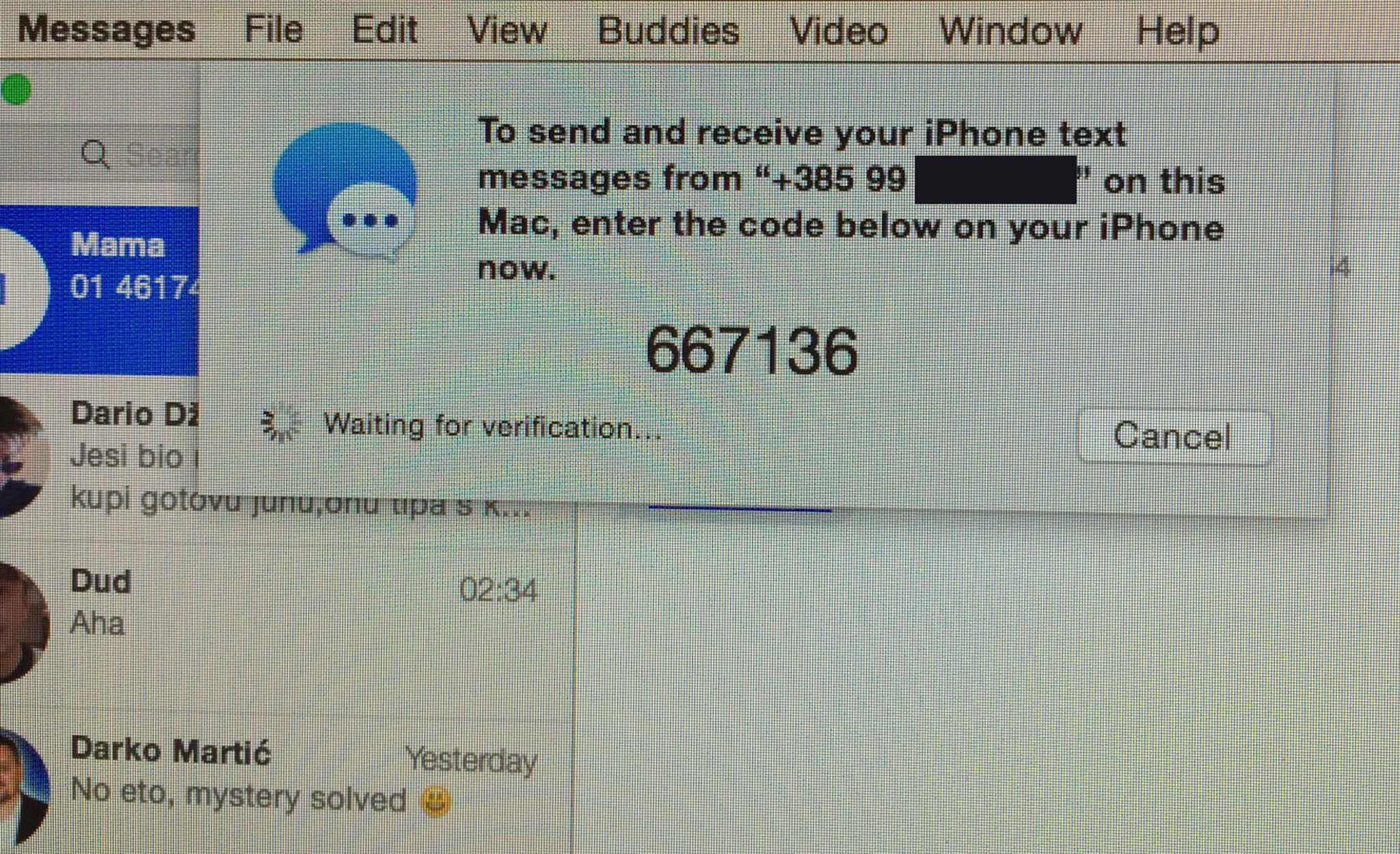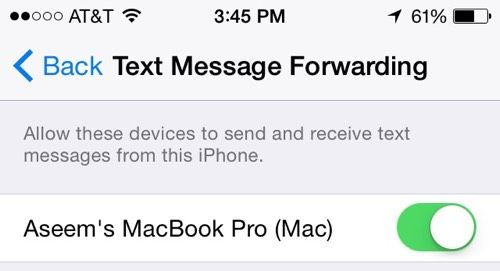- Code Wont Sent To Mac For Text Message Forwarding Iphone
- Code Won't Send To Mac For Text Message Forwarding
- Code Wont Sent To Mac For Text Message Forwarding Mac
To receive text messages on your Mac (from non-Apple devices or when iMessage is unavailable), follow these simple steps follow these simple steps to turn on text message forwarding on your iPhone, so the messages can be available on your Mac.
If you find that iMessage is suddenly not working, and sending all messages as SMS text messages only, or if text message forwarding is no longer working on your iPhone and you are getting no code on your Mac or iPad to set it back up, try this. Some people are finding that, for some reason, either their iPhone is no longer sending messages as iMessages, or is no longer also forwarding plain SMS text messages (such as from friends with Android phones) to their Mac or iPad. The below will address either issue or both issues.
So, first, go to your Messages (iMessage) settings. To get to your iMessage messages settings, go to settings:
Then to Messages:
This will take you to this screen. Ignore everything else for now, and scroll down the Messages settings screen until you get to the “Send & Receive” section.
You should see your iPhone’s phone number already there – go to that setting screen and a) make sure that it has you signed in to your Apple ID (this alone could be the problem if you have been inadvertantly signed out of your Apple account!), and b) add an email address if you don’t already have one set up here.
It should look like this:
If you are not signed in with your Apple ID, it will look like this:
Now, once you are sure that you are signed into your Apple ID, and you have added at least one email address to the Send & Receive section, scroll back up the Messages setting screen and be sure that you have iMessage set to ‘on’ on your iPhone – because, yes, sometimes it magically gets turned off. This can happen, it seems, when, for example, the Apple iMessage servers experience problems, as happened last week.
(Article continues below)| Get notified of new Internet Patrol articles for free! |
| Or Read Internet Patrol Articles Right in Your Inbox! as Soon as They are Published! Only $1 a Month! Imagine being able to read full articles right in your email, or on your phone, without ever having to click through to the website unless you want to! Just $1 a month and you can cancel at any time! |
Again, you want to see iMessage set to on, and, if your problem is that SMS messages aren’t being forwarded to your iPad or Mac, at least one entry under “Text Message Forwarding”:
Now, if your problem is that text message forwarding isn’t working (and it won’t be, if your iMessage setting was set to off, because that removes text message forwarding), you’ll need to go into the Text Message Forwarding section, and re-enable your Macbook or iPad (or both).
This next point is critical: For your iPhone to forward text messages to your other Apple device (Macbook or iPad) the Messages app on that devicemust be signed in with your Apple ID, and it must be the same Apple ID that your iPhone is signed in under. (And you must have ‘Enable this account’ checked next to your Apple ID in the Messages app settings on your Mac or iPad.)
This is because this is how Apple is getting non-iPhone non-iMessage messages to your computer or iPad – via their servers and your Apple account.
Messages iMessage settings on Mac
Once all of this is done, then – and only then – go to your iPhone’s Text Message Forwarding settings, where you should see the device you want to have your iPhone forward messages to. And because everything is set up properly now, when you select the device to which you want the messages to forward, you should now get the code on your Macbook or iPad.
No Paywall Here!
The Internet Patrol is and always has been free. We don't hide our articles behind a paywall, or restrict the number of articles you can read in a month if you don't give us money. That said, it does cost us money to run the site, so if something you read here was helpful or useful, won't you consider donating something to help keep the Internet Patrol free? Thank you!
| Get notified of new Internet Patrol articles! |
Related articles:
By Conner Careyupdated on 02/19/2018
You can send and receive text messages on your Mac if you own an iPhone. As long as you have OS X Yosemite or later, you can get text messages on your Mac. iMessages are sent over an internet connection, so it makes sense that Mac would be able to receive them. But thanks to Apple’s operating system on Mac, you can receive SMS text messages on your computer too. First, we’ll connect iPhone messages to Mac, then we’ll go over how to send and receive text messages (SMS) and iMessages on your Mac. Here’s how to get text messages and iMessages on your Mac computer.
Related: How to Stop & Turn Off Messages on Mac in 4 Easy Steps
Master your iPhone in one minute a day:
Sign up to iPhone Life's Tip of the Day Newsletter and we'll send you a tip each day to save time and get the most out of your iPhone or iPad.
Master your iPhone in one minute a day:
Sign up to iPhone Life's Tip of the Day Newsletter and we'll send you a tip each day to save time and get the most out of your iPhone or iPad.
It’s pretty much always been possible to receive iMessages on your Mac from other Apple device owners. But in 2014, when Apple released OS X Yosemite, the company made it possible to link your iPhone with your Mac. Now, as long as you have that macOS or later, you’re able to get text messages (SMS) on your Mac. Once you’ve set up iMessage on Mac, you should seamlessly receive both iMessages and text messages. Connecting iPhone message to Mac is really just a process of syncing the two up via your iCloud account, which you log into using your Apple ID. Because of this, it is important you use the same Apple ID on your iPhone and Mac, that way the devices know they are on the same continuity network.
By default, Messages on Mac will attempt to send an iMessage. But if it can’t, it will then send a text message. Well, actually it will send the message to your iPhone and your iPhone will send it from there. But for you, it appears as a seamless continuation. This is what allows you to send SMS text messages and iMessage from your Mac to anyone, whether they are using an iPhone or not.
How to Get Text Messages & iMessages on Mac
Operating System Requirements:
The first thing you need to do is make sure your Mac is running at least OS X 10.1 Yosemite. If your Mac is running El Capitan or the latest MacOS Sierra, then you’re good to go as well. You also need to make sure your iPhone is running iOS 8.2.1 or later, although we reccomend running at least iOS 9.3.2 and using the latest version of iOS possible for your iPhone. I’ve broken up the process of getting text message on your Mac into two parts below. Follow it in order and you should have no problems receiving text messages on Mac.
Sign into iCloud on iPhone & Mac:
Code Wont Sent To Mac For Text Message Forwarding Iphone
To receive text messages on a Mac from your iPhone, you’ve got to log into iCloud using the same Apple ID on both devices. You may very well already be logged into iCloud on both devices, but let’s make sure real quick.
On your iPhone, open the Settings app. You should see your Apple ID at the top. Tap that and then tap iCloud. (If you are using an older version of iOS, you will need to go to Settings > iCloud and then log in to your Apple ID.)
On your Mac, open System Preferences. Tap iCloud. Your email address will be under your user icon on the left. Make sure it’s the same as the Apple ID on your iPhone. If you’re not logged in on your Mac, log in.
Now you need to make sure you’re logged in to Messages on Mac. To do this, open the Messages app, tap Messages at the very top of the screen, and select Preferences.
Choose Accounts. Tap the one that says iMessage. Log in using the same Apple ID as you did on your iPhone. If you're already logged in, great!
Code Won't Send To Mac For Text Message Forwarding
Under You can be reached for messages at, make sure you check both your Apple ID email and phone number.
Close Preferences but leave the Messages app open.
Connect iPhone Message to Mac: Text Message Forwarding
Now we need to get your iPhone ready to send and receive text messages on Mac. To do this, we must set up text message forwarding on your iPhone. To do this:
On your iPhone, open the Settings app.
Tap Messages.
Select Send & Receive.
Under You Can Be Reached By iMessage at, make sure both your phone number and Apple ID email address are checked. If not, tap to check them.
Code Wont Sent To Mac For Text Message Forwarding Mac
Go back to Messages. Tap Text Message Forwarding.
Toggle on your Mac.
A box will pop up asking for a code.
On your Mac in the Messages app, a verification code will appear.
Enter the verification code in the box that appeared on your iPhone.
*Troubleshooting Tip:When I started writing this part, I didn’t see Text Message Forwarding under Messages in Settings on my iPhone. I searched everywhere for an answer as to why. It was Sarah, our senior web editor, who thought of the simple solution. Turns out, if you’re not logged into Messages on Mac, you won’t even see the option. So if you run into the same issue, don’t panic. Follow the instructions from part one carefully and it should work smoothly.

Now you’re set up to send and receive text messages and iMessages on your Mac! If you decide you don’t want to receive them anymore, we’ve got an article on that too.
Can I Get iMessage on PC?
Apple is famous for its closed systems, and it’s not much different here. If you have a Mac and a PC, there are some very do-able workarounds. But most people don’t have both, so it’s not practical. The alternative is to jailbreak your iPhone, something we don’t recommend here at iPhoneLife. But if you’re determined, I’d like to point you to our friends at AppleToolBox.
 Master your iPhone in one minute a day: Sign up here to get our FREE Tip of the Day delivered right to your inbox.
Master your iPhone in one minute a day: Sign up here to get our FREE Tip of the Day delivered right to your inbox.